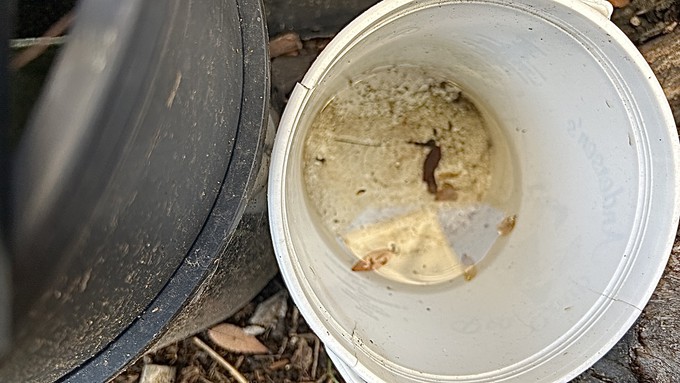
Some trouble spots to look for before Saturday's storm

Oops, something knocked this small bucket to the ground, where it's been collecting water from recent rainstorms. Check around garden equipment as well as plants and drainpipes for water accumulation. Kathy Morrison
It was sunny and bright (and cold!) this morning after Wednesday's clamminess and a bit of rain, but clouds are due to return late this afternoon. And Saturday is expected to be wet, wet, wet all day as another storm rolls in.
There's just enough time walk around the garden for a between-storms checkup. But avoid walking on saturated soil: Stick to sidewalks or stepping stones, if possible. Here's what to look for:
* The last few storms likely showed where the low spots are in your landscape. Mark them with a stick, to remember where they are when the landscape dries out. Or if dogs or people might remove the stick, take a photograph of the location. Especially note to avoid planting anything in that spot that requires good drainage. Here's a link to an earlier post on garden problems that develop -- including crown rot -- when soil gets too much water.
* Depending on the size and location of puddles, you could hoe a temporary drainage ditch away from them or add some garden soil to soak up the water. Don't pack it, however.
* Consider soggy spots for a rain garden, where water can naturally percolate into the ground to irrigate the landscape.
* Make sure storm drains, gutters and downspouts are clear of leaves, sticks and other debris.
* Even better, take a walk around the block and, with a stick or a plant stake, push leaves away from the gutter drains just enough so water won't back up there. Help the neighborhood avoid flooding.
* While you're at it, make sure your downspouts aren't dumping too much water close to the house or garage. Extend the downspouts away from the house and foundation. Ideally, extensions should take rainwater at least 10 feet away from the house. (Read our earlier post on solutions to drainage problems.)
* Tip excess water out of containers. Make sure potted plants aren’t waterlogged, especially succulents, which can turn mushy and even collapse under the influence of excess water and near-freezing winter temperatures.
* Another container check: Are there so many leaves on the soil surface that raindrops can't get through to the soil and the plant's roots? (They're probably draining down the sides or -- eek! -- not draining at all.) Some leaves are OK, but not when they create an organic tarp.
* Eliminate standing water that may have accumulated in wheelbarrows, saucers, piles of unused pots, etc.
* Not everything got watered by the rain. Check plants under patios, eaves and overhangs; they may need a drink.
* Turn off any sprinklers which might still be on. Avoid automatic irrigation for now.
* Search for and pick up large twigs or branches that have fallen or been blown out of trees, especially ones that have landed on top of tender plants. Also, look up into the trees to see if there are other loose branches within reach that you can pull down.
-- Kathy Morrison and Debbie Arrington
Comments
0 comments have been posted.Sacramento Digs Gardening to your inbox.
Sites We Like
Garden Checklist for week of July 21
Your garden needs you!
* Keep your vegetable garden watered, mulched and weeded. Water before 8 a.m. to reduce the chance of fungal infection and to conserve moisture.
* Feed vegetable plants bone meal, rock phosphate or other fertilizers high in phosphate to stimulate more blooms and fruiting. (But wait until daily high temperatures drop out of the 100s.)
* Don’t let tomatoes wilt or dry out completely. Give tomatoes a deep watering two to three times a week.
* Harvest vegetables promptly to encourage plants to produce more. Squash especially tends to grow rapidly in hot weather. Keep an eye on zucchini.
* Pinch back chrysanthemums for bushy plants and more flowers in September.
* Remove spent flowers from roses, daylilies and other bloomers as they finish flowering.
* Pinch off blooms from basil so the plant will grow more leaves.
* Cut back lavender after flowering to promote a second bloom.
* It's not too late to add a splash of color. Plant petunias, snapdragons, zinnias and marigolds.
* From seed, plant corn, pumpkins, radishes, winter squash and sunflowers.